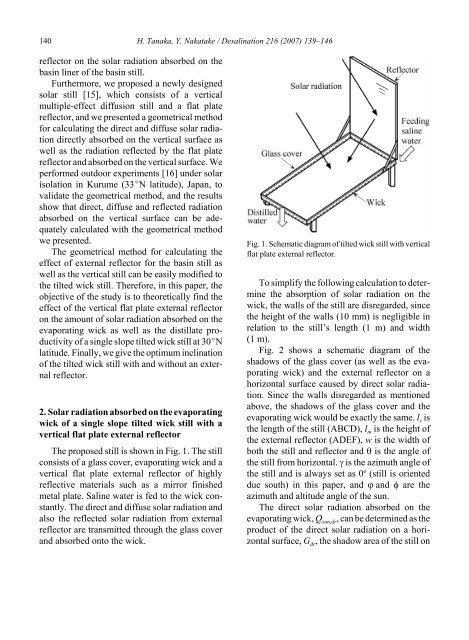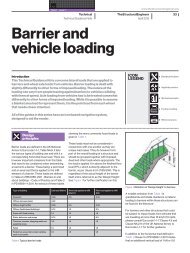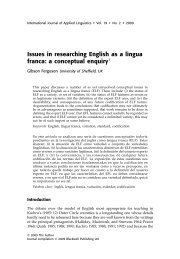Improvement of the tilted wick solar still by using a flat plate reflector
Improvement of the tilted wick solar still by using a flat plate reflector
Improvement of the tilted wick solar still by using a flat plate reflector
Create successful ePaper yourself
Turn your PDF publications into a flip-book with our unique Google optimized e-Paper software.
140<br />
<strong>reflector</strong> on <strong>the</strong> <strong>solar</strong> radiation absorbed on <strong>the</strong><br />
basin liner <strong>of</strong> <strong>the</strong> basin <strong>still</strong>.<br />
Fur<strong>the</strong>rmore, we proposed a newly designed<br />
<strong>solar</strong> <strong>still</strong> [15], which consists <strong>of</strong> a vertical<br />
multiple-effect diffusion <strong>still</strong> and a <strong>flat</strong> <strong>plate</strong><br />
<strong>reflector</strong>, and we presented a geometrical method<br />
for calculating <strong>the</strong> direct and diffuse <strong>solar</strong> radiation<br />
directly absorbed on <strong>the</strong> vertical surface as<br />
well as <strong>the</strong> radiation reflected <strong>by</strong> <strong>the</strong> <strong>flat</strong> <strong>plate</strong><br />
<strong>reflector</strong> and absorbed on <strong>the</strong> vertical surface. We<br />
performed outdoor experiments [16] under <strong>solar</strong><br />
isolation in Kurume (33EN latitude), Japan, to<br />
validate <strong>the</strong> geometrical method, and <strong>the</strong> results<br />
show that direct, diffuse and reflected radiation<br />
absorbed on <strong>the</strong> vertical surface can be adequately<br />
calculated with <strong>the</strong> geometrical method<br />
we presented.<br />
The geometrical method for calculating <strong>the</strong><br />
effect <strong>of</strong> external <strong>reflector</strong> for <strong>the</strong> basin <strong>still</strong> as<br />
well as <strong>the</strong> vertical <strong>still</strong> can be easily modified to<br />
<strong>the</strong> <strong>tilted</strong> <strong>wick</strong> <strong>still</strong>. Therefore, in this paper, <strong>the</strong><br />
objective <strong>of</strong> <strong>the</strong> study is to <strong>the</strong>oretically find <strong>the</strong><br />
effect <strong>of</strong> <strong>the</strong> vertical <strong>flat</strong> <strong>plate</strong> external <strong>reflector</strong><br />
on <strong>the</strong> amount <strong>of</strong> <strong>solar</strong> radiation absorbed on <strong>the</strong><br />
evaporating <strong>wick</strong> as well as <strong>the</strong> di<strong>still</strong>ate productivity<br />
<strong>of</strong> a single slope <strong>tilted</strong> <strong>wick</strong> <strong>still</strong> at 30EN<br />
latitude. Finally, we give <strong>the</strong> optimum inclination<br />
<strong>of</strong> <strong>the</strong> <strong>tilted</strong> <strong>wick</strong> <strong>still</strong> with and without an external<br />
<strong>reflector</strong>.<br />
2. Solar radiation absorbed on <strong>the</strong> evaporating<br />
<strong>wick</strong> <strong>of</strong> a single slope <strong>tilted</strong> <strong>wick</strong> <strong>still</strong> with a<br />
vertical <strong>flat</strong> <strong>plate</strong> external <strong>reflector</strong><br />
The proposed <strong>still</strong> is shown in Fig. 1. The <strong>still</strong><br />
consists <strong>of</strong> a glass cover, evaporating <strong>wick</strong> and a<br />
vertical <strong>flat</strong> <strong>plate</strong> external <strong>reflector</strong> <strong>of</strong> highly<br />
reflective materials such as a mirror finished<br />
metal <strong>plate</strong>. Saline water is fed to <strong>the</strong> <strong>wick</strong> constantly.<br />
The direct and diffuse <strong>solar</strong> radiation and<br />
also <strong>the</strong> reflected <strong>solar</strong> radiation from external<br />
<strong>reflector</strong> are transmitted through <strong>the</strong> glass cover<br />
and absorbed onto <strong>the</strong> <strong>wick</strong>.<br />
H. Tanaka, Y. Nakatake / Desalination 216 (2007) 139–146<br />
Fig. 1. Schematic diagram <strong>of</strong> <strong>tilted</strong> <strong>wick</strong> <strong>still</strong> with vertical<br />
<strong>flat</strong> <strong>plate</strong> external <strong>reflector</strong>.<br />
To simplify <strong>the</strong> following calculation to determine<br />
<strong>the</strong> absorption <strong>of</strong> <strong>solar</strong> radiation on <strong>the</strong><br />
<strong>wick</strong>, <strong>the</strong> walls <strong>of</strong> <strong>the</strong> <strong>still</strong> are disregarded, since<br />
<strong>the</strong> height <strong>of</strong> <strong>the</strong> walls (10 mm) is negligible in<br />
relation to <strong>the</strong> <strong>still</strong>’s length (1 m) and width<br />
(1 m).<br />
Fig. 2 shows a schematic diagram <strong>of</strong> <strong>the</strong><br />
shadows <strong>of</strong> <strong>the</strong> glass cover (as well as <strong>the</strong> evaporating<br />
<strong>wick</strong>) and <strong>the</strong> external <strong>reflector</strong> on a<br />
horizontal surface caused <strong>by</strong> direct <strong>solar</strong> radiation.<br />
Since <strong>the</strong> walls disregarded as mentioned<br />
above, <strong>the</strong> shadows <strong>of</strong> <strong>the</strong> glass cover and <strong>the</strong><br />
evaporating <strong>wick</strong> would be exactly <strong>the</strong> same. l s is<br />
<strong>the</strong> length <strong>of</strong> <strong>the</strong> <strong>still</strong> (ABCD), l m is <strong>the</strong> height <strong>of</strong><br />
<strong>the</strong> external <strong>reflector</strong> (ADEF), w is <strong>the</strong> width <strong>of</strong><br />
both <strong>the</strong> <strong>still</strong> and <strong>reflector</strong> and θ is <strong>the</strong> angle <strong>of</strong><br />
<strong>the</strong> <strong>still</strong> from horizontal. γ is <strong>the</strong> azimuth angle <strong>of</strong><br />
<strong>the</strong> <strong>still</strong> and is always set as 0 o (<strong>still</strong> is oriented<br />
due south) in this paper, and ϕ and φ are <strong>the</strong><br />
azimuth and altitude angle <strong>of</strong> <strong>the</strong> sun.<br />
The direct <strong>solar</strong> radiation absorbed on <strong>the</strong><br />
evaporating <strong>wick</strong>, Q sun,dr, can be determined as <strong>the</strong><br />
product <strong>of</strong> <strong>the</strong> direct <strong>solar</strong> radiation on a horizontal<br />
surface, G dr, <strong>the</strong> shadow area <strong>of</strong> <strong>the</strong> <strong>still</strong> on

















